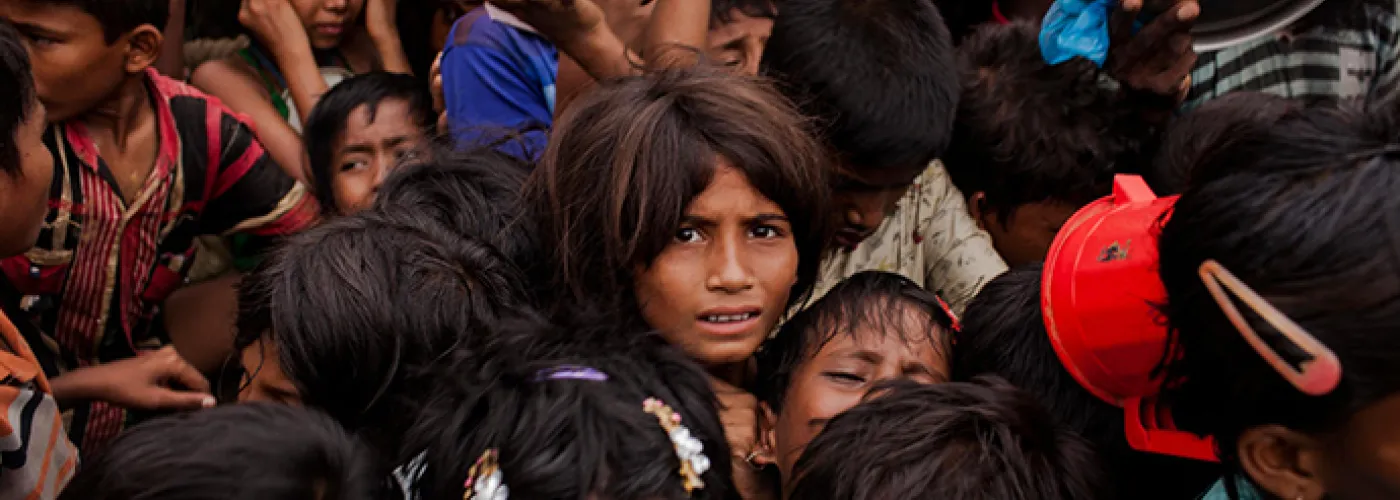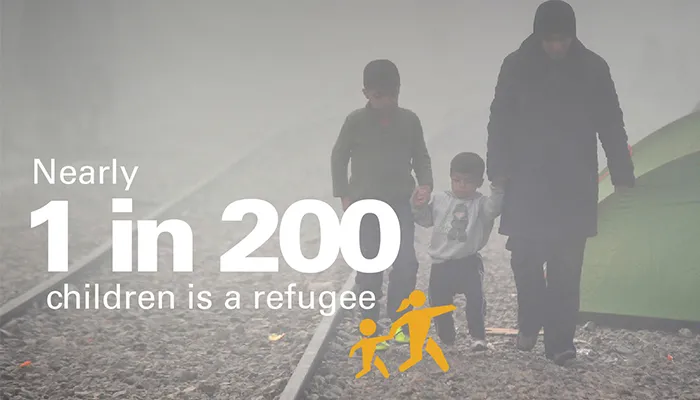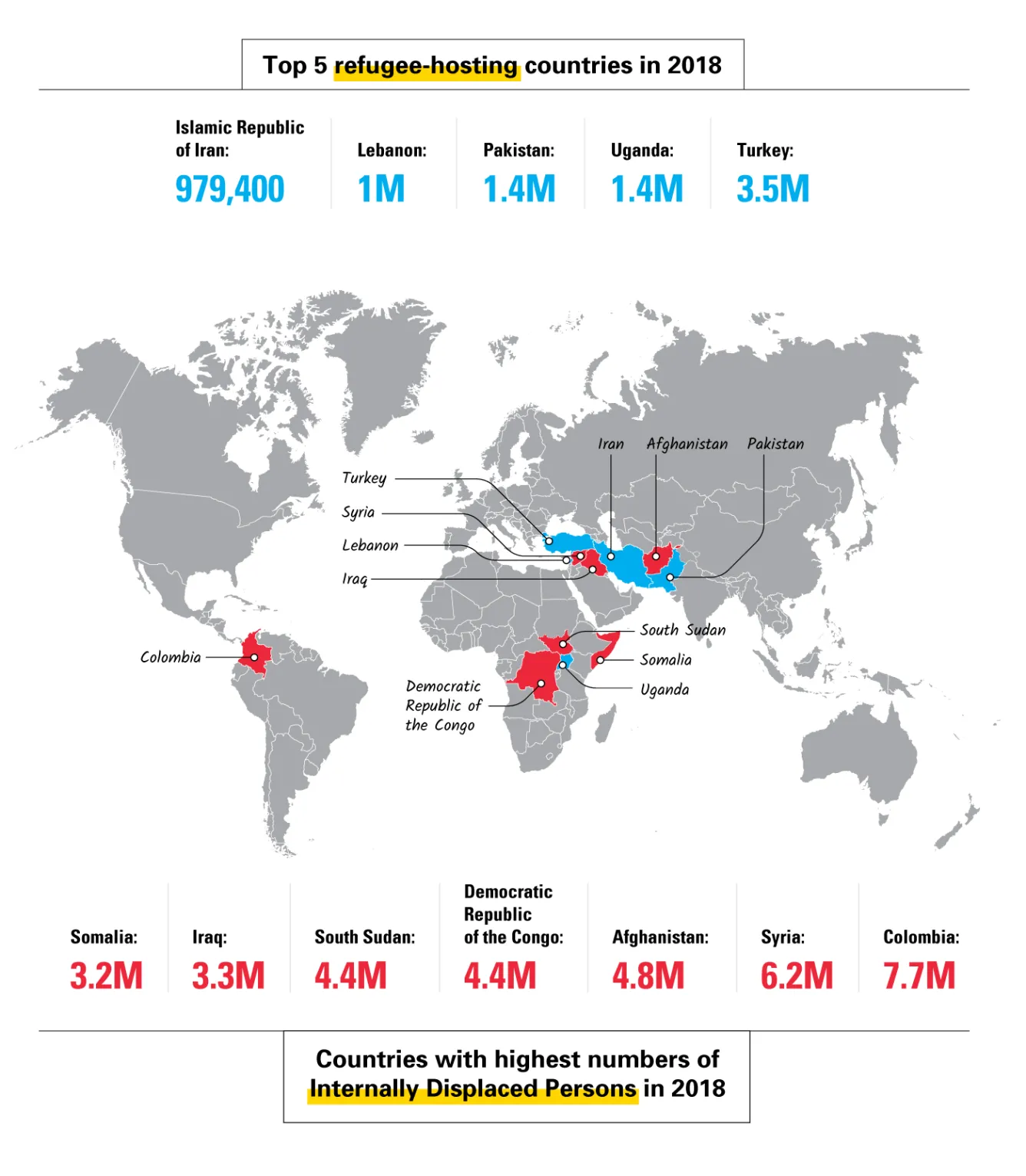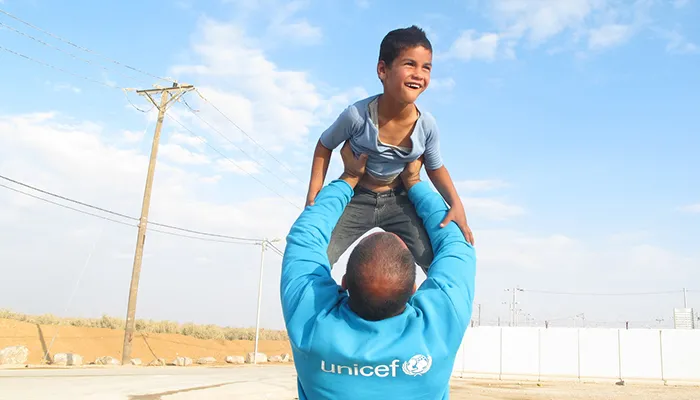Around the world, nearly 50 million children have become refugees or migrants after fleeing their homes to escape conflicts and natural disasters – others have migrated in the hope to find a better life. You can help children in crisis through UNICEF.
The world is facing a lost generation with the largest number of refugees and internally displaced people since World War II. Millions of children and adolescents are spending their entire young lives on the move, driven from their homes because of situations of conflict, natural disasters and humanitarian emergencies. Children do not bear any responsibility for the bombs and bullets, the gang violence, persecution, the shriveled crops and low family wages driving them from their homes. But they are the first to be affected by war, conflict, climate change and poverty.
No matter where they come from, wherever they are, children are children and they need protection
Donate now to support UNICEF’s action for child refugees and migrants.
REFUGEE AND MIGRANT CHILDREN AMONG MOST VULNERABLE OF ALL CHILDREN
Millions of children migrate safely, for educational and employment opportunities, in search of a better life.
But millions more have had to flee, or have been uprooted from their homes by violence, war, poverty, persecution, exclusion, and the effects of climate change.
Around the world, nearly 50 million children have been forced from their homes. More than half of these girls and boys fled violence and instability. That’s equal to three quarters of Canada’s population. Every last one of them is seeking a different life than the one they left behind. Like every child, they just want to be safe and happy.
These children may be refugees, internally displaced or migrants. But first and foremost, they are children - no matter where they come from, who they are, and without exception.
Refugee, migrant, displaced – who are the children uprooted
Migrant: A person who is moving or has moved across an international border or within a home country regardless of whether the move is voluntary or involuntary and regardless of the length of stay.
Refugee: A person who lives outside the country of nationality and is unable to return because of persecution or fear of persecution based on race, religion, nationality, membership of a particular social group or political opinion.
Asylum seeker: A person who seeks refuge in a country to which they have fled because of persecution.
Internally displaced persons: People who fled their homes – but not their countries – because of armed conflict, violence, disaster or a violation of human rights.
Uprooted: A general, non-legal term used by UNICEF for people who have left their place of origin for any reason. They may be migrants, refugees or internally displaced.
5 quick facts about uprooted children
- 50% of refugee children worldwide are not in school.
- Two-thirds of all refugees worldwide come from just 5 countries: Syria, Afghanistan, South Sudan, Myanmar and Somalia.
- Conflict displaces even more people within their own borders than beyond them.
- Some of the main reasons forcing IDPs to leave their homes are armed conflict, situations of generalized violence, violations of human rights or natural or human-made disasters.
- In 2017, an estimated 16.2 million people were newly displaced, including 11.8 million displaced within the borders of their own countries.
Children forced to flee their home seek safety anywhere they can find it - in nearby towns, schools, settlements, internal camps, even forests and fields. On the run, they can face tremendous danger while seeking security abroad or within their own country. Uprooted children face violence, exploitation, disrupted social services and education, and separation from their families. The longer displacements linger, the more lasting their negative effects can be.
Root causes of migrations – why children flee their homes
Every year, in every part of the world, children and families make the decision - sometimes freely and sometimes under duress - to move. These decisions are influenced by a wide range of factors about their present conditions and their future aspirations.
Difficult conditions at home - conflict, poverty, violence, natural disasters, unemployment, discrimination and more - often weigh heavily in the decision to move.
Brighter prospects in other countries – security, family reunification, education, higher standards of living and jobs – also shape decisions about where and when families migrate.
Children and families rarely make the decision to move for just one reason. Many factors are usually involved and the importance of any given factor may change over time.
THE CHALLENGES: CHILDREN ON THE MOVE FACE GRAVE DANGERS
Driven from their homes by conflicts they didn’t create, children face dangers like trafficking, kidnapping, the risk of drowning on sea crossings, malnourishment, sexual violence and even murder. Children, particularly those who travel on their own or become separated from their families, are at risk of many forms of violence and exploitation throughout their journeys. For some, those dangers persist even after they have reached their destinations. Refugee and migrant children disproportionately face poverty and exclusion when they reach destination countries.
Read the story of these 7 Gambian boys who became friends despite their harrowing journey.
Children need protection
Violence linked to Boko Haram in the Lake Chad region - Nigeria, Cameroon, Chad and Niger - has led to widespread displacement; over 1.3 million children are on the move. Watch the journey of this family as they struggle to find safety.
1 in 3 children are out of school in countries affected by war or natural disasters
Education can make or break the futures of children and young people. For those living in countries affected by protracted conflicts and complex humanitarian emergencies, quality education is especially critical. Education provides children with the stability and structure they need to cope with the trauma they have experienced. And it equips them with the knowledge and skills they need to help rebuild their country once the conflict or disaster is over.
Education provides children and young people with the skills they need to contribute to their countries and economies, and hope for a better future. Without investment for education in emergencies, the world could face losing an entire generation of children living in countries affected by conflict and disaster.
Urgent investment is needed to get these children and young people - who are already living in the most challenging of circumstances - into safe school and learning.
Donate today to provide education for children in need around the world.
UNICEF is committed to addressing the needs of the most vulnerable kids in the world:
SOLUTIONS - WHAT DOES UNICEF DO TO HELP CHILD MIGRANTS AND REFUGEES?
Children should feel safe from violence and exploitation. They should be able to stay with their families. They shouldn’t have to miss school or not be able to go to the doctor. They shouldn’t fear xenophobia or discrimination. They should be able to feel at home – wherever home is.
UNICEF works around the world to help make sure migrant and refugee children are protected and that their rights are respected. With donor support, we:
- provide life-saving humanitarian supplies in refugee camps.
- run child-friendly spaces – safe places where migrant and refugee children can play, where mothers can rest and feed their babies in private, and where separated families can reunite.
- support national and local governments to put in place laws, policies, systems and public services that are inclusive of refugee and migrant children, address their specific needs and help them thrive.
- help keep families together.
What is UNICEF’s agenda for action to protect all refugee and migrant children
UNICEF calls for 6 actions to help protect every child uprooted by war, violence and poverty.
- Press for action on the causes that uproot children from their homes
- Help children to stay in school and stay healthy
- Keep families together and give children legal status
- End the detention of refugee and migrant children by creating practical alternatives.)
- Combat xenophobia and discrimination.
- Protect children from exploitation and violence.
Read more about UNICEF’s Agenda for Action
Migrant and refugee children in Canada
As a leader in efforts to protect the rights of migrant and displaced people, especially children, Canada should continue to effectively use its international assistance, diplomacy, and voice on the global stage to ensure the protection of the most vulnerable boys and girls. We encourage Canada to remain a global champion of the rights of the children on the move.
When Canada ratified the Convention on the Rights of the Child in 1991, it committed to respect and ensure the rights of every child within its borders, without discrimination of any kind. We should always have children’s best interests guide every decision that affects them.
While Canada has been a leader in establishing immigration processes recognizing the rights and dignity of all people, our policies and services fail some vulnerable children and can be improved. Canada has partially implemented UNICEF’s Agenda for Action, but we can make simple changes to help children reunite with their families and prevent the harm that can befall them when they are separated.
- Put best interests of every child first. If the best interests of the child were a primary consideration in all decisions affecting children and their voices were heard, Canada would better protect children who are alone, on the move and very vulnerable. The best interests of the child should be a primary consideration in decisions not only about welcoming or returning children, but also about the family members they are migrating with; in alternatives to detention; in full access to public services including health, childcare and education; in placement in alternative care; and in seeking citizenship.
- Keep families together. Keeping families together is one of the best ways to protect children – it’s why every child has the right to preserve their family ties. Children who come to Canada alone leaving parents behind, and those left behind by parents who come to Canada, should be reunited with their families within 6 months if it’s in their best interests. Detention is never in the best interests of a child. Children should not be detained in prison-like adult facilities to keep families together, nor should they be put into foster care while their parents are detained.
Canada has demonstrated global leadership responding to the needs of refugees and displaced children and families through a comprehensive response to the Syrian sub-regional and refugee crises. The Syria Emergency Relief Fund for instance provided critical immunizations, life-saving support, education and protection from violence, for some of the most vulnerable Syrian children. Canada renewed its commitments to ensure that the educational needs of children and youth are prioritized as part of Canada’s response to the Syria crisis through its significant support of more than $160 million to the No Lost Generation initiative.
6 THINGS YOU CAN DO TO HELP REFUGEE AND MIGRANT CHILDREN
Learning about the child refugee crisis can feel overwhelming. It’s natural to wonder what one person can do to help the nearly 50 million children on the move. The answer is: plenty.
When you stand with us, you can make a profound difference. Here are some ways to get started.
- Donate
A monthly or one-time donation to UNICEF Canada goes a long way to helping children around the world. Your gift enables the protection, care, support and services all children need to survive and thrive.
- Shop for children
UNICEF Canada’s Survival Gifts® are real gifts with real impact that are guaranteed to reach children in the world’s toughest places, when they need them most. Whether you buy on behalf of yourself or as a gift for a loved one, you will make a real difference to children who need help.
- Discover UNICEF’s work with children in emergencies around the world, thanks to our donor support.
The child refugee crisis is a worldwide story, and not one that’s confined to a single region. Our Humanitarian Action for Children spans the globe and confronts the complex and unique needs of every child whose life has been upended.
- Learn more about the child refugee crisis
When you understand what life is like for the nearly 50 million uprooted children around the world, your world view opens up. Your compassion is ignited. Empathy and understanding comes flooding in. Action follows.
- Find out how Canadians are making a difference
Hundreds of Canadians are working with UNICEF around the world to protect and promote the rights of vulnerable children. Here some Canadians of who are making a difference on the ground.




